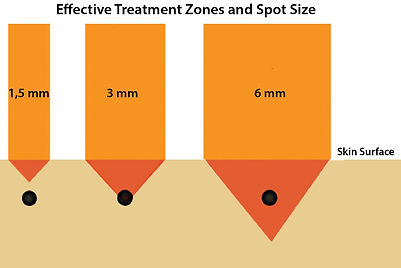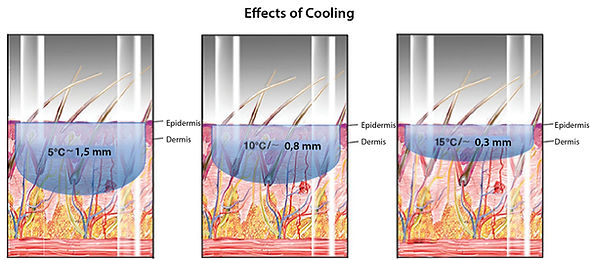Technical Information
In order to understand the applied effective treatment with electromagnetic radiation devices used in skin treatments and to use these devices effectively, some basic information and parameters must be known very well.
CHROMOPHOR: Molecules absorbing light are known as chromophores. They are biological molecules that absorbs or detect light energy. When light strikes the chromophore, it causes a structural change in the molecule.
There are three main chromophores in the skin: hemoglobin, water molecules and melanin pigment giving color to the skin. Inks applied externally to the skin surface form tattoo pigments.
To understand the absorption of light by the skin, let's examine the absorption spectrum given in Figure 1. As can be seen, while visible light between 400 nm and 800 nm is absorbed by oxyhemoglobin with melanin pigment in the skin, it does not affect the water molecules. However, infrared light after 900 nm starts to be absorbed by the water molecules in the skin.

This absorption mechanism can show the effect of chromophores on its target after light enters the skin. It is very important here which wavelength of light can penetrate to which layers of the skin, in other words, the depth of penetration and which chromophores affect. For this reason, 4 parameters must be fully understood in the treatment of skin with laser devices and devices using beams. These are;
Figure 1: Light absorption spectrum of the three main chromophores in the skin
1. Wavelength 2. Energy Density (Fluence) 3. Pulse Duration 4. Cooling. After determining these parameters according to the treatment area of your patient, you should start treatment.
1. WAVE LENGTH: It is the most important physical size that determines the color of light like chromophore. In general, the unit of measurement is nanometer. We should use proper wavelength according to the depth of chromophores or pigments to treat the target area in the depth of the skin.
The absorption depths of light of different wavelengths in the skin are shown in Figure 2 A,B below.


There are two basic principles in light tissue interactions: absorption and scattering. Absorption is critical in targeted effective treatment. When higher absorption and less scattering, less heating energy will be required to bring the target to the desired temperature. It is desirable in the treatment. The functioning of absorption and scattering mechanisms in the skin differs according to the wavelength.
Figure 2.A
Figure 2.B
As an example, in Figure 2.B, penetration depth over 1200 nm decreases as the wavelength increases. This is because the interaction power of the light with the water molecules in the skin becomes dominant. In short, If a suitable wavelength is chosen, effective treatment can be performed.
2. ENERGY DENSITY (FLUENCE): Energy applied to the unit area. Briefly, it is called Fluence. It’s unit is Joule / cm2. Sufficient energy must be delivered to the target during treatment. The energy density in the skin depth decreases exponentially depending on the energy density in the skin surface and when it reaches a certain depth, its effect disappears.
Energy Density, FLUENCE = Energy / Beam Area = Joule / cm2
Beam Area or Spot Area: It is the area of light energy falling on the skin in cm2.
Beam Diameter or Spot Diameter: It is the diameter of the circular shape in millimeters (mm) formed by the light energy falling on the skin. The spot area is adjusted by selecting the spot size in the devices and attaching the appropriate heads to the hand tools.
From two beams with the same energy density, the larger spot diameter reaches deeper, However, this creates more heat effect on the skin, which can lead to painful treatment. When the spot diameter is reduced, the depth of penetration decreases, but creates a more superficial treatment effect. Energy density decreases rapidly when the spot diameter is lower than the penetration depth.

In the figure, you can schematically see the treatment response obtained by changing the spot diameter and energy intensity. A beam of 6 mm spot diameter hits the skin and within the skin this energy takes the form of an bullet head. In this case, approximately 63% of the photon concentration on the surface is located under the skin. If we can encompass 63% concentration to treat our goal, effective treatment will occur.
It is important to understand the effect of spot diameter on penetration depth for effective treatment. Energy density (Fluence) and spot diameter must be adjusted together according to skin color and hair structure.

3. PULSE DURATION: It is the time between the beginning and finishing of energy delivery. A number of pulses can be in small packages. The devices apply instant energy packets to the skin in short time intervals such as nanoseconds, microseconds and milliseconds.
Thermal Relaxation Time (TRT; Thermal Relaxation Time): It is the time that the energy absorbed by the target chromophore is distributed to the surrounding tissues. The given energy heated up the target and the time that passes until is cooled down is called the thermal relaxation time.

If the target size is large, the thermal relaxation time will be long. Such targets are treated by applying energy with a long puklse duration time. Treatment is insufficient when energy is applied to a tissue with a large target mass in a short pulse durations.
For effective treatment, the pulse duration time should be shorter than the thermal relaxation time of the target to be well treated.
Device Operating Frequency: The device can apply 1, 2, 3 or multiple times per second from instant shots. In this case, the number of pulses per unit time of device determines the operating speed of that device and the time of treatment. However, it should not be forgotten that when the operating speed is increased in all laser devices, your consumption costs will increase as the instantaneous power drawn from the device will increase. Forexample; like the difference between the fuel consumption of a vehicle traveling at 90 km / h and the fuel consumption of a vehicle traveling at 180 km / h.
4. COOLING: The important issue in effective treatment is the cooling method. Cooling is mainly used to protect the epidermis from excessive heat. It aims to maximize laser treatment with thermal damage to target chromophores (superficial veins, hair follicle or dermal water) and to cause minimal damage to the superficial epidermis. Cooling is also important in determining how to protect the superficial layers and without compromising the effectiveness of the laser.

Cooling the skin layers reduces unwanted thermal injuries to the epidermis. The effect of cooling temperature on the skin is given above. As the cooling temperature decreases, the effect increases on the depths of the skin.
While the heat is transmitted to the target by selective photothermolysis, it causes unwanted warming in the epidermis. Improper use of a beam-based system or insufficient cooling in the epidermis may result in burns or blisters. Cooling is also used to reduce pain in treatment. All skin cooling systems have some advantages and disadvantages. However, most manufacturers will say that their cooling systems are better than others. Cooling systems operating on different principles will provide adequate protection for the epidermis when used correctly.
Cooling with cold Air: The cold air blowing output of a device is focused on to the surface of skin and cool down the levels of dermis.
Gas Cooling: The gas outlet of a tube filled with freon (cryogen) gas is applied to the skin surface and the skin is cooled.
Cooling by Direct Contact: A cooled solid body is kept in contact with the skin and the skin is cooled by heat conduction.
Cooling with Gel: It is tried to cool the skin with the gel applied on the skin surface.
These cooling techniques can be applied to the desired area before treatment, as well as during and after treatment.
For example; If the pulse duration is choosed between 20-100 milliseconds and deep targets are selected. Then an effective precooling and parallel cooling is provided in these areas This benefits significantly in the treatment of darker skin types.
We tried to summarize and simplify the basic principles of laser devices used for effective skin treatment. This information is thought to be useful in determining the critical parameters and device settings to be used in the treatment.
